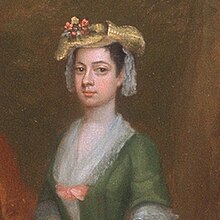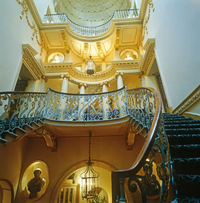| Lady Isabella Finch | |
|---|---|
 Lady Isabella Finch in 1732 Lady Isabella Finch in 1732 | |
| Born | May 1700 |
| Died | 1 March 1771 Berkeley Square |
| Position held | Lady of the Bedchamber |
Lady Isabella Finch (1700 – 1771) was a Lady of the Bedchamber to the Hanoverian Princess Amelia. She never married and wielded political power.
Life
Lady Isabelle Finch was born in 1700 to Daniel Finch, 2nd Earl of Nottingham and Hon. Anne Hatton . Her mother had been a Lady of the Bedchamber to Queen Mary II in 1691 and she was pregnant 22 times, therefore Lady Bell had at least twelve siblings. Bell was the fourth surviving child and the family home was at Burley on the hill, Rutland which was designed by her father whom she admired.

Finch became Lady of the Bedchamber to Princess Amelia in 1738 or thereabouts. The Princess was a spinster and the aunt of King George III.

In 1740 she commissioned William Kent to build her a townhouse at 44 Berkeley Square which is famed for its theatrical staircase. It was built between 1742 and 1744 and she was very involved in its design, proven by her lengthy correspondences with her brother in law 1st Marquess of Rockingham. She was known for entertaining guests at her home and these included Princess Amelia, Horace Walpole and the duke and duchess of Newcastle. Walpole was not her greatest fan, he wrote about her appearance and her "dusky hue" which she shared with other members of her family.

Thomas Pelham-Holles, 1st Duke of Newcastle was the Prime Minister and she wasn't timid in approaching him. She wrote to him to ask about the Princess's pension which was in arrears in 1761. She had identified that others had received their arrears and the Princess had not. Her pointed letters resulted in the arrears being paid.
In 1747 she caused a rift in the Finch family when she did not agree to present her brother's illegitimate child at court.
Death and legacy
She probably died at her home in Berkeley Square in 1771. The house was inherited by her brother Edward Finch and later bought by William Henry Fortescue, 1st Earl of Clermont (1722–1806) as his London townhouse and was again visited by Princess Amelia. In the 20th century it became the Clermont Club.
References
- ^ Chalus, E. H. (2004-09-23). Finch, Lady (Cecilia) Isabella [Bell] (1700–1771), courtier. Vol. 1. Oxford University Press. doi:10.1093/ref:odnb/68377.
- "TWO AUTOGRAPH LETTERS SIGNED ("MARIE R"), TO ANNE, COUNTESS OF NOTTINGHAM". Sothebys.
- ^ Learmouth, Juliet. "The London Town House of Lady Isabella Finch" (PDF). The Georgian Group Journal. XXV: 73–94.
- ^ 44 Berkeley Square: A Commentary by Lord Kinross, Illustrated by Adrian Daintrey, London, 1962